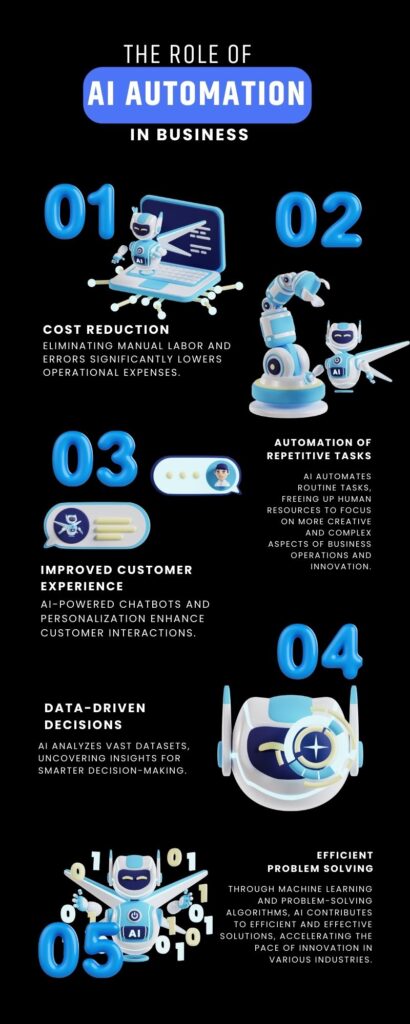My journey into business automation began when I noticed the inefficiencies in my work processes. Manual tasks such as data entry, report generation, and customer communication consumed a significant amount of my time. It wasn’t until I discovered the power of AI-driven automation that I was able to free up hours each week to focus on high-value tasks like strategy development and innovation.
The integration of business automation software in our business processes turned out to be a game changer. The invoices now process themselves, customer inquiries are handled with lightning speed, and data analysis now just takes minutes instead of days. That’s the power of business automation with AI.
In today’s fast-paced digital landscape, companies that fail to adapt to automation risk are falling behind the competition. In this comprehensive guide, we’ll delve into exploring the benefits, and practical strategies of implementing business automation in your company to help you streamline operations and boost profits.
“Whatever you are studying right now, if you are not getting up to speed on deep learning, neural networks, etc., you lose. We are going through the process where software will automate software, automation will automate automation.”
– Mark Cuban
Direct Cost Savings
One of the most significant advantages is the ability to eliminate the need for manual labor on repetitive tasks. According to a study by Gartner, companies that implement automation solutions can slash their operational costs by up to 30%.
One of my cousins was telling me an account that he experienced himself when running a small accounting firm. The invoicing and accounts receivable processes in the firm were incredibly time-consuming, requiring one of his employees to generate and send out invoices regularly manually. It was a tedious, error-prone job that detracted from more strategic work.
That all changed when he implemented an AI-powered invoicing and payment solution. Instead of having an employee handle these tasks, the business process automation tool was able to create, send, and track invoices automatically. This freed the firm’s team members to focus on higher-value activities like client advisory and financial planning.

The cost savings were substantial – the team members at the firm estimated that automating these repetitive AR processes saved them thousands of dollars per year in labor costs alone. And the benefits went beyond just the bottom line. With the invoicing handled automatically, they were able to get paid faster and improved their overall cash flow.
Eliminating the need for manual data entry, invoice generation, and payment processing is just one way that AI-driven business automation can deliver direct cost savings. Whether you run a small firm or a large enterprise, finding opportunities to automate repetitive tasks by using Artificial Intelligence for business can have a significant impact on your operational expenses. It’s a strategy that I highly recommend to any company looking to streamline their operations and boost their profitability. AI and business are set to complement each other for increased productivity.

Indirect Cost Savings
In addition to direct cost savings, business automation with AI also leads to indirect cost savings. Automation reduces the likelihood of human error, which can result in costly mistakes and rework. Furthermore, automation enables businesses to optimize their processes, reducing the need for additional resources and infrastructure.
Consider a manufacturing company that automates its inventory management system. By using AI-powered algorithms to track and predict demand, the company can minimize waste, reduce the need for excess inventory, and optimize its supply chain. This not only saves on the direct costs of inventory storage and handling but also indirectly reduces the risk of stockouts, production delays, and customer dissatisfaction.
Revenue Growth
Business automation with AI can also drive revenue growth by improving customer satisfaction and loyalty. By automating tasks such as customer service and support, you can ensure that customers receive prompt and personalized responses, leading to increased satisfaction and loyalty. According to a study by Pardot, businesses that use automation to improve customer service see a significant increase in customer retention rates.
For instance, an e-commerce company that integrates AI-powered chatbots into its website can provide 24/7 customer support, answering common questions and resolving issues quickly. This not only improves the customer experience but also frees up the company’s customer service team to focus on more complex inquiries, leading to higher customer satisfaction and repeat business.

Intangible Benefits of Business Automation Software
Beyond the financial benefits, business automation with AI also offers intangible benefits. Automation can improve employee morale and job satisfaction by reducing the burden of repetitive tasks. Automated businesses respond quickly to changing market conditions and customer needs, giving them a competitive edge.
For example, a marketing agency using AI for business can automate its social media posting and analytics. This frees up the company’s team to focus on more strategic content creation and campaign planning. This not only improves employee satisfaction but also allows the agency to be more agile and responsive to the evolving needs of its clients.

Calculating ROI
When calculating the return on investment (ROI) for business automation with AI, it’s essential to consider both the direct and indirect costs. By automating tasks and processes, you can reduce operational costs, improve efficiency, and increase revenue. According to a study by IBM, businesses that implement automation solutions can see an ROI of up to 200% within the first year.
To calculate the ROI of your business automation initiatives, start by identifying the specific processes you want to automate and the associated costs. Then, estimate the potential savings and revenue gains from automating these processes. Finally, compare the total benefits to the implementation and ongoing costs of the automation solution to determine the overall ROI.

Conclusion
Business automation with AI is a powerful tool for streamlining operations and boosting profits. By automating repetitive tasks, improving customer satisfaction, and reducing costs, businesses can achieve significant benefits. As an AI expert, I’ve seen firsthand the transformative power of automation, and I’m excited to share my insights with you. Also, AI is prone to AI hallucinations, which is an AI system producing inaccurate or weird results. However, AI hallucination can be reduced by choosing an AI tool that incorporates Grounding AI as an approach to align their system with real-world data. Human in the loop is another approach that is utilized in these AI tools which involves human oversight of AI outputs that ensures enhanced credibility.
Whether you’re a small business owner or a large corporation, business automation with AI is an essential strategy for staying competitive in today’s fast-paced digital landscape. By implementing the strategies and best practices outlined in this guide, you can unlock the full potential of your business and drive sustainable growth.
Tired of wasting hours on tedious, repetitive tasks that drain your energy and distract you from your important work? Bionic is an easy-to-use automation tool that takes care of your time-consuming, repetitive work. Request a demo now!